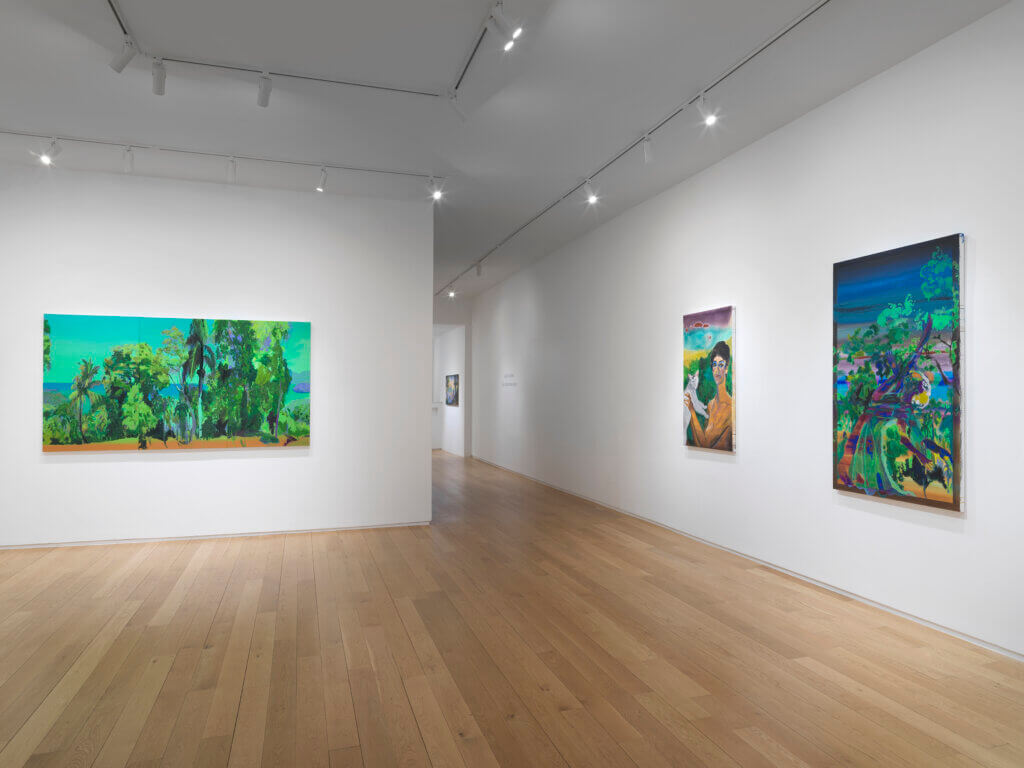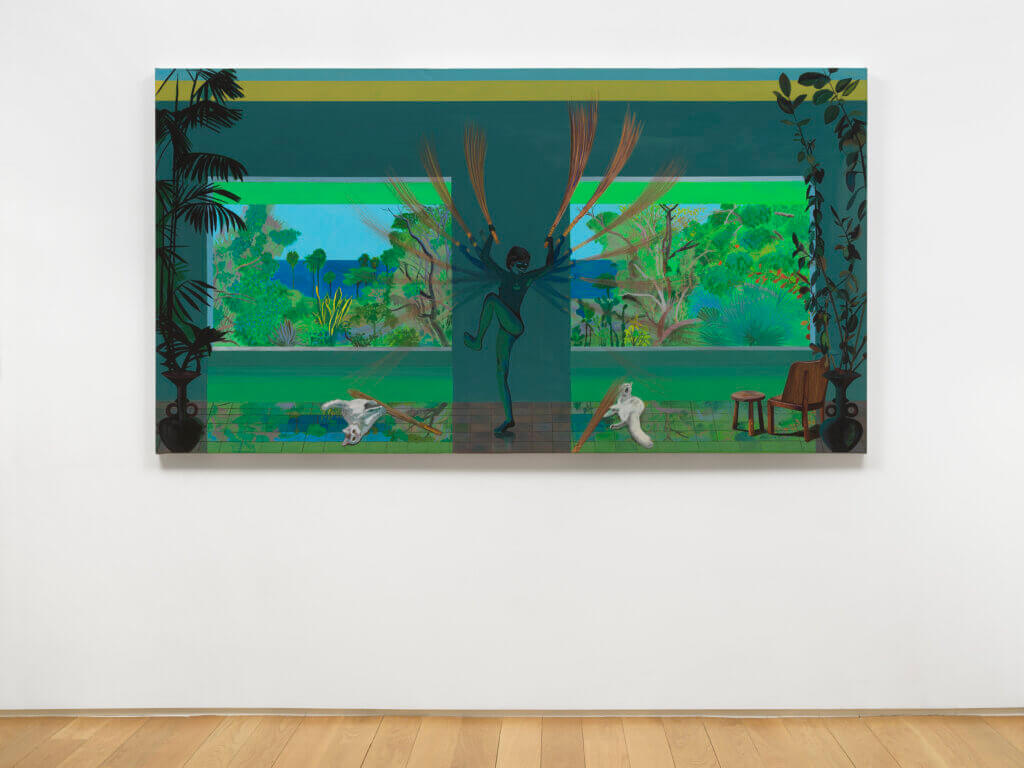By Andrew Woolbright
June 2023

Installation view of Hulda Guzmán: They come from water (May 24-July 5, 2023) at Alexander Berggruen, NY.
There’s a way that bodies can only figure themselves when they are relaxed–a slack that comes from the dependability of safety and love. Arms and legs hang with a certain freedom when aware they won’t be let go of, unfurling and sprawling in comfort. In this state, bodies can forget their angles and joints, and shift to their longest forms and greatest lengths. These are the bodies that belong to each other; of slipping eyeglasses in late afternoons, open windows, and the fading light of emerald greens and eclipsing pink.
This phenomenon of trust runs like an undercurrent throughout Hulda Guzmán’s latest exhibition They come from water. It is a trust that extends beyond human relationships, wading further out to find kinship within the forest and the land. Guzmán interweaves the bodily and natural ancestries of the Dominican, expressing a figuration of passage that is indistinct and inseparable from the landscape. It is a way of being that harbors coexistence, hosting a series of boundary crossings between the land and the interior inscribed within it. The interiors in Guzmán’s world reflect the exteriors. Reflections of continents linger on the surface of the water. The windows stay open. The mountains hide self-portraits within them. Nature invites itself in. It is the speechless intimacy of a friend who reaches for something in the fridge, knowing everything will be reciprocated in time. Guzmán’s tropically-wooded paintings meditate on the trees that divide bodies of water from the inland. She depicts a land without anything selfish within it, an archipelago of safety that grows in the days after a storm. It is a space where life resumes after trouble, knowing more trouble is to come, but not for now. In the meantime, it is the soft considerations of walking carefully around the cat sprawled out on the bed so as not to wake it; as the midday sun casts deep shadows over a laptop with drafts of things left unfinished.

Hulda Guzmán
The favorite show, 2023
acrylic gouache on linen
60 x 37 in. (152.4 x 94 cm.)
Guzmán’s exhibition practices a politics of water, of fluidity, of easy movements and porous spread. It is an eased passage between bodies, species, and land that circulates without barricades or fences. In warm waters (2023) a group sails out from the shoreline at dusk. It reveals an effortlessness within connectivity, a free flow that carries throughout the show. The only time Guzmán has painted herself in the show is in Pets. Are they real? (2023), where she depicts herself holding up a cat under its arms. It is a familiar pose for those that live with animals–it is the way you pick one up to kiss them. The cat hangs similarly relaxed to the figuration that is seen in Eddy y Bo 1 (2023) and Eddy y Bo 2 (2023). One depicts a child piggybacking along with his grandfather who is also the artist’s father. In the other, he hangs comfortably upside down, held in his grandfather’s arm, who smiles as he goes to fix his slipping glasses. I know you’ll catch me, each body seems to say. They share in private utopias where nothing is encroached. Deleuze would describe this as smooth space–a space without structures of delineation. It is in these fluid states, but also states of enmeshment, that the spaces for radical states of becoming are possible. Hegel wrote of intimacy–of what can be learned from and produced when different things are held in close proximity, long enough to inform each other.
This enmeshing is most visible within the works where Guzmán shifts her focus to the tree line, to the overgrowth of foliage, copse, and hurst. She explores the calligraphy found in interlocking branches, with families of tropical birds finding space within each moment of enclosure. In Hojas de fuego (2023) the congregations of marks, of staining, form beautiful entanglements of camouflage and safety. Birds hide their dazzling colors in the subtle architectures of brambles and limbs. They call to each other within the trellised vines and roots. Guzmán’s staining process forms drained trees meeting swelling ground. Guzmán paints each one flat, pouring first and then spreading with the brush. It expresses a fecund world of immediate adjacency, of sharing attention and resources, a world without want.

Hulda Guzmán
La rotonda, 2023
acrylic gouache on linen
45 x 45 in. (114.3 x 114.3 cm.)
Guzmán’s work has loosened up to meet the contingent world she is exploring. This exhibition marks a shift from her past interest in crisp edges; that can you can still see in works like La rotonda (2023) and avatara (2023), where foliage weaves and repeats like densely-packed fabrics. Now the body itself becomes a site of passage; of inky wells of transparency and banding. This is most visible in psychedelic wave (2023), where the horizon passes through the body in deep, pooling spills of paint. The richly dark alizarins and idanthrones render a body of glowing shadows. The staining and pouring of paint that Guzmán utilizes to fill in the skin, allows her to focus on the distinctive gesture of each figure. The washy acrylic gouache passes light through it, feeling instantaneous and rhythmic, with real boundaries. No posture is generalized. Each body is specific.
There is also a language of magic at play–the signs of ritual and of something being evoked. The symmetry of Disciplina (2023) enchants a chore with spiritual suffusion. A woman stands with a leg raised and her arms rotating, an enumeration of limbs cycling or flapping, a winding Shiva swinging out with long brooms. Two cats lie on the floor, relaxing on the landscape that is revealed through the cleaning and reflected in the tiles. It is a subtle magic, whereas autoflowering (2023) portrays a body of flora, where skin has been replaced with grass inflorescence. Guzmán depicts the patterning found in raceme and panicle to be grown within, the body as landscape and the landscape as body, blending figure and landscape while camouflaging them both within each other. It is a vibrant interchange that gestures towards an interest in magic realism, but more immediately, longs for a spell that brings the world together. Nothing is meager. Everything is full and tan from a day of sun and being in the water.

Hulda Guzmán
Disciplina, 2023
acrylic gouache on linen
48 1/8 x 88 3/4 in. (122.2 x 225.4 cm.)
Andrew Paul Woolbright is an artist, gallerist, and Editor-at-Large at The Brooklyn Rail, living and working in Brooklyn, NY. Woolbright is an MFA graduate from the Rhode Island School of Design in painting and is the director of the Lower East Side Gallery Below Grand. He currently teaches at Pratt and School of Visual Arts in New York.
This essay was published on the occasion of Alexander Berggruen‘s exhibition Hulda Guzmán: They come from water (May 24-July 5, 2023).

Installation view of Hulda Guzmán: They come from water (May 24-July 5, 2023) at Alexander Berggruen, NY.
Photos: Dario Lasagni